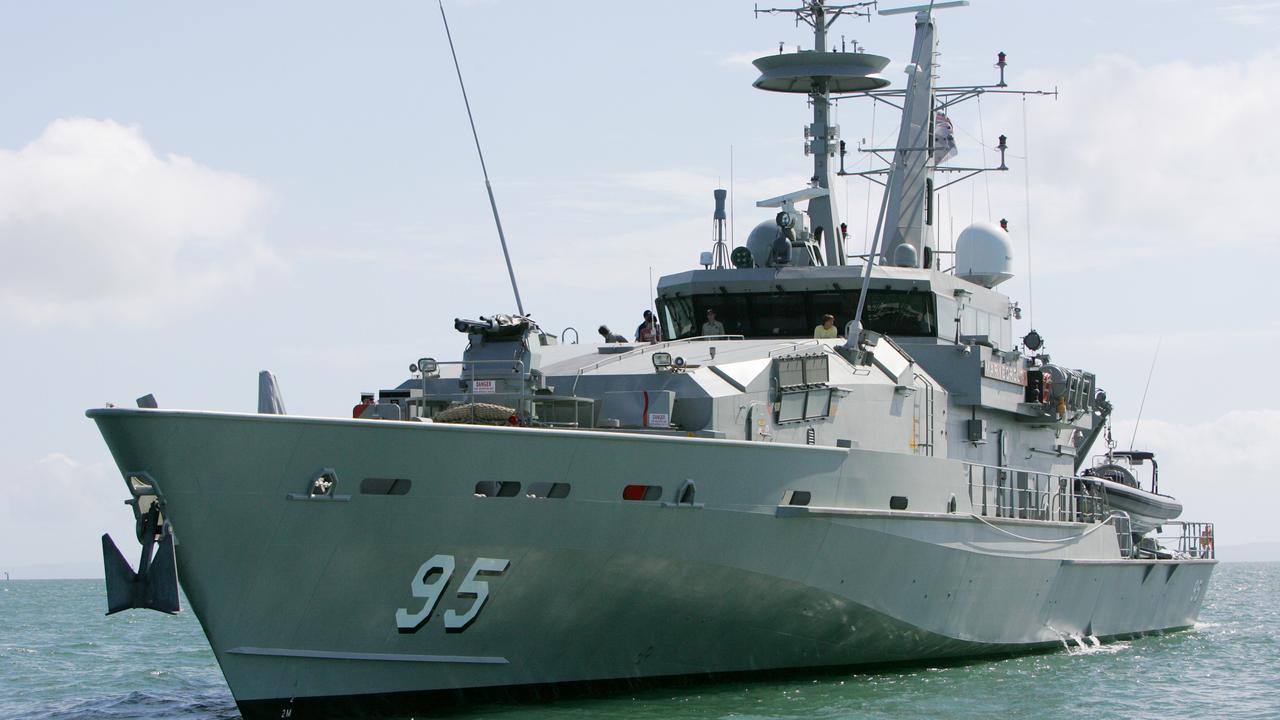Britannia rules waves: UK’s $35bn frigate win
Cabinet’s national security committee awards BAE Systems the contract to build nine of the world’s most advanced warships.

The largest peace-time warship building program in Australian naval history has been awarded to British defence giant BAE Systems under a $35 billion contract to deliver nine of the most advanced anti-submarine warfare vessels in the world.
Cabinet’s national security committee last night signed off on the “hunter-killer” global combat ship as the future backbone of the nation’s defence posture in the region.
The deal is expected to create 4000 Australian jobs and deliver the most technologically advanced stealth-capable submarine killer as the replacement for the eight ageing Anzac-class frigates that began service in 1996. The new fleet will be assigned as the Hunter Class with construction to begin in 2020 and the first ship delivered by 2027 in what a Defence source said was the most significant warship project since World War II.
A statement issued last night after the NSC meeting confirmed that construction would take place in South Australia at the Osborne shipping yard and ensure a continuous naval shipbuilding industry until at least 2042.
GRAPHIC: Hunter Class frigates
The deal was signed at 5pm by NSC members including Malcolm Turnbull, Defence Industry Minister Christopher Pyne, Defence Minister Marise Payne and Finance Minister Mathias Cormann. The Prime Minister will announce the decision this morning in Adelaide, with the government expected to use the estimated 2000 South Australian jobs created under the project as a key campaign pitch in the upcoming by-election in Mayo.
The future frigates will become pivotal to defence capabilities in the region against the backdrop of increasing Chinese military activity. With the rapid increase in the number of submarines being deployed in the region, combat vessels with anti-submarine capability are regarded as critical for Australia’s defence needs.
The Defence source said the BAE-designed ships were “state of the art” and would be the most capable vessel of its kind. “They kill submarines,” the source said.
The frigates, at a cost of about $4bn each, will form the last piece in sovereign naval defence capabilities, which include the offshore patrol vessels, the $9bn air warfare destroyer program and the 12 new French-built submarines that will cost $50bn. BAE Systems won the contract ahead of competing bids by Italian firm Fincantieri and Spain’s Navantia. It will be the largest surface warship project commissioned and rivalled only by the submarine project.
Critics of the BAE Systems bid argue that the type 26 global combat ship has yet to see service as no ships have been built, whereas the Spanish and Italian ships were in service. This was considered by the Australian Strategic Policy Institute as the highest risk option for likely cost overrun.
The decision to go with BAE was based on a Defence assessment that the global combat ship was “by far and away” the most capable and lethal ship of the three. Britain’s Royal Navy is expected to have ships in service several years ahead of the first Australian ship being delivered.
British MP Bob Seely, Member of the Foreign Affairs Select Committee, said: “Inter-operability across naval forces is key part of shared defence. The more we can share platforms the closer co-operation can be at the operational level and the greater the potential to save taxpayers dollars and pounds.’’
According to the Defence source, the British bid had an “added bonus” of being delivered by one of Australia’s closest strategic and political allies and a partner in the “five-eyes” intelligence network that also includes the US, Canada and New Zealand.
Mr Turnbull said the decision to go with the BAE bid was based on sheer capability.
“The frigates, to be designed by BAE Systems and built by ASC Shipbuilding, are central to our plan to secure our nation, our naval shipbuilding sovereignty and create Australian jobs,” the Prime Minister’s statement said.
After a comprehensive competitive evaluation process, the government had assessed BAE’s global combat ship as having the capability best suited for Australia. “(It) will provide our nation with one of the most advanced anti-submarine warships in the world — a maritime combat capability that will underpin our security for decades to come,” he said.
“The Hunter class will provide the Australian Defence Force with the highest levels of lethality and deterrence our major surface combatants need in periods of global uncertainty. The Hunter class will have the capability to conduct a variety of missions independently, or as part of a task group, with sufficient range and endurance to operate effectively throughout the region.
“The frigates will also have the flexibility to support non-warfare roles such as humanitarian assistance and disaster relief.”
The ships’ combat platform will include the US Navy’s Aegis combat-management system and Australian-developed CEA phased-array radar. It will also be fitted with an advanced anti-ship missile system, sea sparrow missiles, and MK41 vertical launch defence systems. The ship will carry a torpedo-armed Romeo helicopter with space for a second Romeo or drone.
The government said the Australian component of the contract would be 65-70 per cent, which would create about 4000 direct and indirect jobs. More than 500 businesses across the country had been “prequalified” for the contract’s supply chain. Mr Turnbull said the frigates would be “built in Australia, by Australians, using Australian steel”. “This $35bn program will create 4000 Australian jobs right around the country and create unprecedented local and global opportunities for businesses large and small,” he said.
As a requirement of the bid, a corporate structure would be created, with the government-owned ASC, the former Australian Submarine Corporation, made a subsidiary of BAE systems for the duration of the contract. The federal government would retain a sovereign share of ASC, which would return to full federal government ownership at the end of construction. BAE would be responsible for the design and the ASC for the majority of construction. The statement said this “ensures BAE Systems is fully responsible and accountable for the delivery of the frigates and ensures the work will be carried out by Australian workers and create Australian jobs”.
The government said that at the end of the delivery scheduled for 2042, ASC would retain intellectual property, a skilled workforce and associated equipment.






To join the conversation, please log in. Don't have an account? Register
Join the conversation, you are commenting as Logout